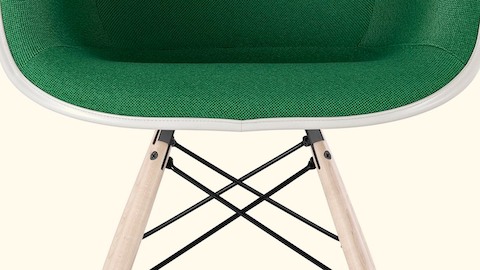Visit the factory floor at Eagle Packaging in Zeeland, Michigan, and you’ll see something surprisingly rare. It’s not the protective packaging for heavy, valuable furniture and automotive products that the company is known for, and it’s not the attention to detail that has made Eagle such a hit with companies like Herman Miller. It’s a company-wide focus on problem-solving design, on seeing the big picture, zeroing in on the underlying challenge.
“Eagle prides themselves on thinking differently,” says president Patrick Patten. “A lot of packaging companies begin their thought process based on their own products, asking ‘How can we sell our boxes to a company like Herman Miller?’ But we decided from the outset that we would not think in terms of selling boxes. We think about safer, easier, environmentally neutral transport. That means we may design a solution using any of a number of materials, so long as they solve our customers’ biggest delivery problems.”
Under Patten’s leadership, Eagle Packaging has pushed its brand of problem-solving design to solutions both large and small, and in the process has made every level of its operation more sustainable. Perhaps Patten and vice president Dan Gibson’s biggest innovation is the development of their patented CorrLoc system, which uses corrugated paper to create strong and protective pallets, cases, and braces.
According to Patten and Gibson, standard wooden pallets and packaging present myriad problems: They’re prone to insect infestations, they’re not recyclable, they’re heavy to move, and they can damage building interiors during transit.
“People are cutting down trees basically to shove them in a landfill,” Gibson says. “We can do better.”
CorrLoc, however, is light, recyclable, and strong, and Eagle Packaging has sorted out how to tailor it to even the mostly unusually sized products—looking at you, Eames Tandem Sling Seating. The cornerstone of the CorrLoc system is the cardboard brace, which forms the basis of the paper pallets and can also be used for vertical packaging. It’s an open square tube with a triangle layered inside of it; the triangle, which helps give the brace structure and strength, also acts as a shock absorber. It’s this brace, which is structured like a two-by-four, that supports the base of the corrugated cardboard packaging that keeps products like our Bolster Sofa and the elegant Noguchi Table secure during shipping.
“Force dissipates along the triangle and then bounces back,” Gibson says. “In a wooden load, the force passes through to the product.”
Beyond merely protecting the Herman Miller products within, the braces are the foundation of the cardboard pallets, which are used as stand-alone pieces to transport items during shipping. They weigh no more than a quarter of what standard wooden pallets do and can carry up to 15,000 pounds. The versatility of cardboard has also allowed Eagle Packaging to streamline even more and create custom shipping boxes that have pallets built into them.
“The industry has the philosophy that you either have a box or you have a pallet,” Gibson says. “Here, the box is the pallet.”
Better still, CorrLoc functions as a modular system; if one part of the pallet or packaging is damaged, it can be cut off and replaced with another cardboard piece or brace and reused multiple times.
Patten, a member of Michigan’s Grand Traverse Band of Ottawa and Chippewa Indians, recalls Gibson telling him, “You’re really using your Native American ancestry. You’re using everything, even scrap.”
“My mom was very poor,” Patten says, “they had to use everything. She always used to joke that she had to walk to school with cereal boxes on her feet in the snow.” His mother’s stories cemented in his mind that “there was so much waste out there.”

Just as Eagle Packaging looks to maximize every material and resource on the shop floor, it also looks for opportunities to maximize the potential of its people. To be great at problem-solving, Eagle looks to build problem-solvers. A case in point, assembly workers are trained to read blueprints.
“We use it as a visual cue. [Assembly workers] see prints and numbers, especially for very complex products,” says Gibson. “It’s different than most plants we go into. A lot of times they’re building something and they’re not sure what the next piece of the puzzle is. My staff sees the whole puzzle.”
An additional benefit: much of Eagle Packaging’s staff is Spanish-speaking, making the visual language of blueprints a powerful communal language. According to Gibson, Eagle’s largely minority workforce, “forces you to think about things differently and creates innovation.”
That’s a perfect metaphor for what Patten, Gibson and Eagle Packing do—solve clients’ problems with a canny mix of technological know-how, people-centered practices, and the old maxim: reduce, reuse, recycle.
Back on the shop floor, there’s another example of the Eagle ethos at work. A big box that holds what look like discarded ends of cardboard is actually a collecting point for corner boards, pieces of cardboard that protect the edges in bulk product shipments. After their first use, the corners are cut into five-inch banding pieces that support Herman Miller chair backs during shipping. Eagle Packaging finds a new life for even these lowly castoffs.
Check out our Better World Report to read more about how we and our partners are designing our way to a more sustainable future.
Related Articles
-
-

Heirloom Apparent
Fifty years after it was purchased, an Eames Lounge Chair and Ottoman begins its third chapter with a new generation of the same design-loving New York family. -

Doing Quality: A modest proposal for honoring Eames
WHY revisits Ralph Caplan’s 1978 essay “Doing Quality” as a reminder that Herman Miller’s greatest commitment to Charles & Ray Eames’ legacy is a commitment to quality.






